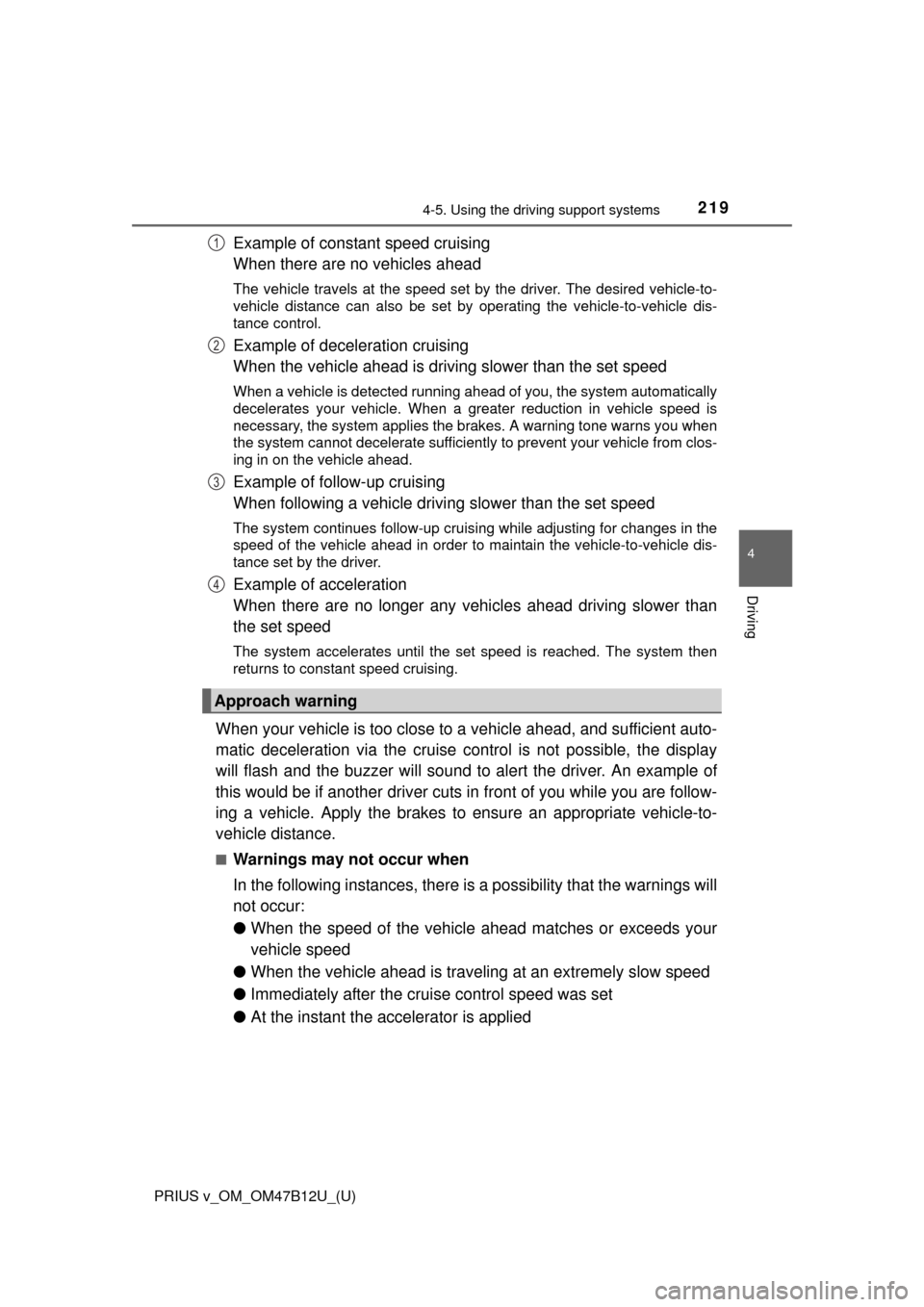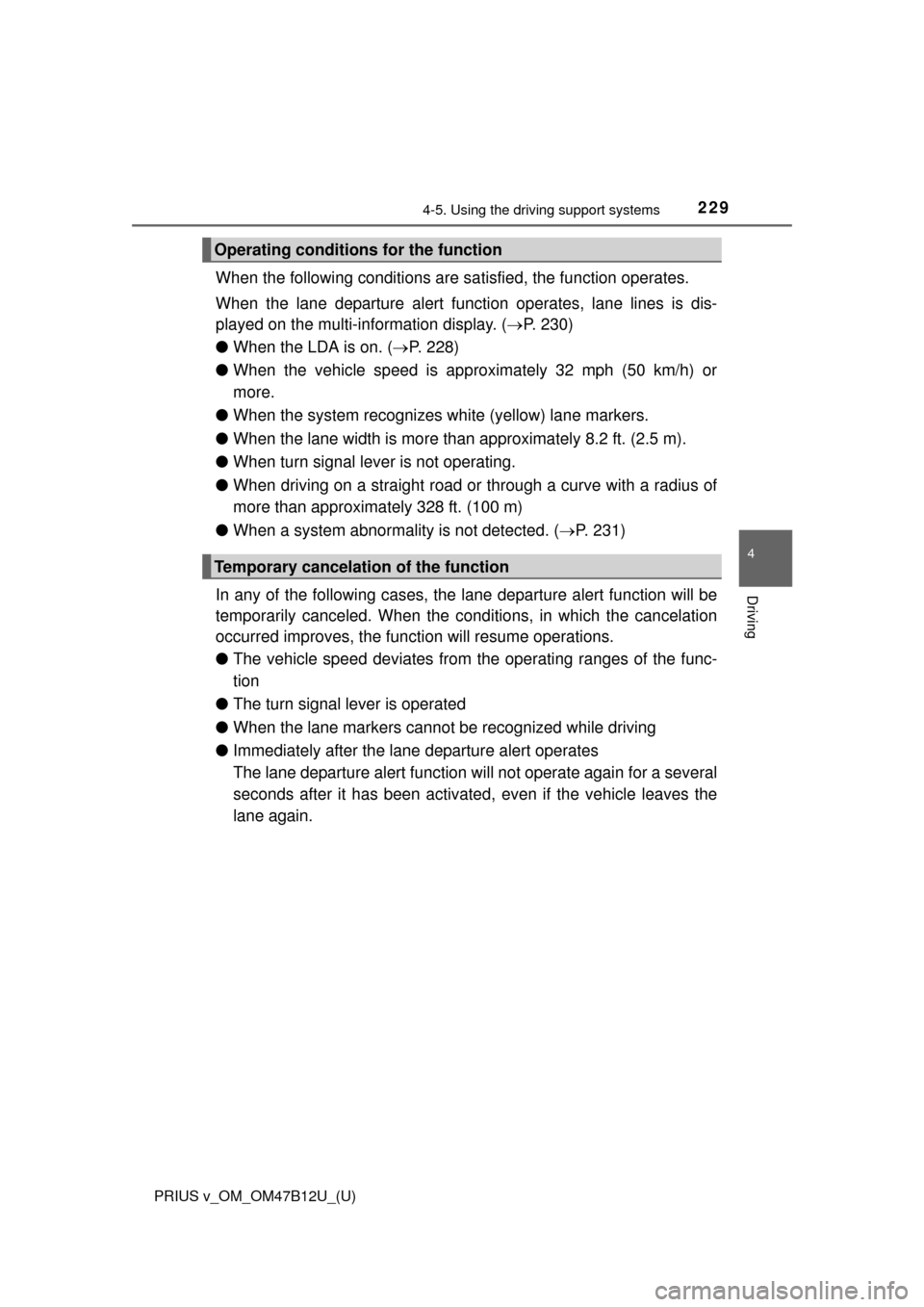Page 217 of 620
PRIUS v_OM_OM47B12U_(U)
2174-5. Using the driving support systems
4
Driving
Pressing the button changes the vehicle-to-vehicle distance as fol-
lows:
Long
Medium
Short
The vehicle-to-vehicle distance is
set automatically to long mode
when the power switch is turned to
ON mode.
If a vehicle is running ahead of
you, the preceding vehicle mark
will also be displayed.
Select a distance from the table below. Note that the distances shown
correspond to a vehicle speed of 50 mph (80 km/h). Vehicle-to-vehicle
distance increases/decreases in accordance with vehicle speed.
Changing the vehicle-to-vehicle distance
Preceding vehicle mark
1
2
3
Vehicle-to-vehicle distance settings
Distance optionsVehicle-to-vehicle distance
LongApproximately 160 ft. (50 m)
MediumApproximately 130 ft. (40 m)
ShortApproximately 100 ft. (30 m)
Page 219 of 620

PRIUS v_OM_OM47B12U_(U)
2194-5. Using the driving support systems
4
Driving
Example of constant speed cruising
When there are no vehicles ahead
The vehicle travels at the speed set by the driver. The desired vehicle-to-
vehicle distance can also be set by operating the vehicle-to-vehicle dis-
tance control.
Example of deceleration cruising
When the vehicle ahead is driving slower than the set speed
When a vehicle is detected running ahead of you, the system automatically
decelerates your vehicle. When a greater reduction in vehicle speed is
necessary, the system applies the brakes. A warning tone warns you when
the system cannot decelerate sufficiently to prevent your vehicle from clos-
ing in on the vehicle ahead.
Example of follow-up cruising
When following a vehicle driving slower than the set speed
The system continues follow-up cruising while adjusting for changes in the
speed of the vehicle ahead in order to maintain the vehicle-to-vehicle dis-
tance set by the driver.
Example of acceleration
When there are no longer any vehicles ahead driving slower than
the set speed
The system accelerates until the set speed is reached. The system then
returns to constant speed cruising.
When your vehicle is too close to a vehicle ahead, and sufficient auto-
matic deceleration via the cruise control is not possible, the display
will flash and the buzzer will sound to alert the driver. An example of
this would be if another driver cuts in front of you while you are follow-
ing a vehicle. Apply the brakes to ensure an appropriate vehicle-to-
vehicle distance.
■Warnings may not occur when
In the following instances, there is a possibility that the warnings will
not occur:
●When the speed of the vehicle ahead matches or exceeds your
vehicle speed
●When the vehicle ahead is traveling at an extremely slow speed
●Immediately after the cruise control speed was set
●At the instant the accelerator is applied
Approach warning
1
2
3
4
Page 227 of 620
227
PRIUS v_OM_OM47B12U_(U)
4-5. Using the driving support systems
4
Driving
LDA (Lane Depar ture Alert)
While driving on a road that has lane markers, this system recognizes
the lane markers using a camera as a sensor to alert the driver when
the vehicle deviated from its lane. If the system judges that the vehicle
has deviated from its lane, it alerts the driver using a buzzer and indi-
cations on the multi-information display.
Camera sensor
Display
Indicator
LDA switch
: If equipped
Summary of function
1
2
3
Page 228 of 620
228
PRIUS v_OM_OM47B12U_(U)
4-5. Using the driving support systems
When the system judges that the vehicle is deviating from the current
traffic lane, an alert buzzer sounds and it prompts cautions from the
display screen of the multi-information display.
When the alert buzzer sounds, please check the surrounding road situa-
tion and return near the center of the white (yellow) lane markers by safely
operating the steering wheel.
Press the LDA switch to activate
the LDA.
LDA indicator will come on and
lane lines will be displayed on the
multi-information display.
Press the switch again to deacti-
vate the LDA.
The LDA will remain on or off even
if the power switch is turned off.
Lane departure alert function
Alert buzzer
Turning the LDA on
Page 229 of 620

PRIUS v_OM_OM47B12U_(U)
2294-5. Using the driving support systems
4
Driving
When the following conditions are satisfied, the function operates.
When the lane departure alert function operates, lane lines is dis-
played on the multi-information display. (P. 230)
●When the LDA is on. (P. 228)
●When the vehicle speed is approximately 32 mph (50 km/h) or
more.
●When the system recognizes white (yellow) lane markers.
●When the lane width is more than approximately 8.2 ft. (2.5 m).
●When turn signal lever is not operating.
●When driving on a straight road or through a curve with a radius of
more than approximately 328 ft. (100 m)
●When a system abnormality is not detected. (P. 231)
In any of the following cases, the lane departure alert function will be
temporarily canceled. When the conditions, in which the cancelation
occurred improves, the function will resume operations.
●The vehicle speed deviates from the operating ranges of the func-
tion
●The turn signal lever is operated
●When the lane markers cannot be recognized while driving
●Immediately after the lane departure alert operates
The lane departure alert function will not operate again for a several
seconds after it has been activated, even if the vehicle leaves the
lane again.
Operating conditions for the function
Temporary cancelation of the function
Page 230 of 620
230
PRIUS v_OM_OM47B12U_(U)
4-5. Using the driving support systems
When the inside of both lane lines
turn white:
Indicates that both right and left
lane markers are recognized.
If the vehicle deviates from the traf-
fic lane, the lane display on the
side the vehicle has deviated from
will flash in amber. (P. 228)
When the inside of either lane line
turns white:
Indicates that the lane marker on
the white-marked side is recog-
nized.
If the vehicle deviates from the side
of a lane with recognized lane
markers, the lane line will flash in
amber. (P. 228)
When the inside of both lane lines
are black:
Indicates that no lane markers are
recognized or the LDA is tempo-
rarily canceled.
Indication on the multi-information display
Page 231 of 620

PRIUS v_OM_OM47B12U_(U)
2314-5. Using the driving support systems
4
Driving
■LDA indicator
Even if the LDA switch is pressed, when the LDA indicator does not come on
the system may have a malfunction. Have the vehicle inspected by your Toy-
ota dealer immediately.
■Alert buzzer for lane departure alert
Depending on the audio system sound level or air conditioning fan noise
while the audio system or air conditioning system is in use, it may be difficult
to hear the alert buzzer.
■After the vehicle has been parked in the sun
The LDA may not be available and a warning message will be displayed for a
while after driving has started. When the temperature in the cabin decreases
and the temperature around the camera sensor (P. 227) becomes suitable
for its operation, turn the LDA switch on again after a short time.
■If there are lane markers on only one side of the vehicle
The lane departure alert will not operate for the side on which lane markers
could not be recognized.
■Conditions in which the function may not operate correctly
In the following situations, the camera sensor may be unable to recognize
lane markers causing the lane departure alert function to operate incorrectly.
However, this does not indicate a malfunction.
●When there are shadows on the road running parallel with lane markers, or
if a shadow covers the lane markers
●When driving through an area with no lane markers, such as a toll booth, a
crossing or before a ticket checkpoint
●When the lane markers are broken, Botts’ dots (raised pavement markers)
or stones
●When lane markers are obscured or partially obscured by sand, dirt, etc.
●When driving on a road surface that is wet due to rain, previous rainfall,
standing water, etc.
●When the lane markers are yellow (These may be more difficult for the sys-
tem to recognize compared to white markers.)
●When the lane markers are on a curb, etc.
●When driving on a particularly bright road surface, such as concrete
●When driving on a road surface that is bright due to reflected light
●When driving in a location where the light level changes rapidly, such as the
entrance to or exit from a tunnel
●When sunlight or the headlights of oncoming vehicles are shining directly
into the camera lens
●When driving on roads that are branching or merging
●When driving on winding roads or roads that are uneven
Page 232 of 620

232
PRIUS v_OM_OM47B12U_(U)
4-5. Using the driving support systems
●When driving on rough or unpaved roads
●When driving on a sharp curve
●When lane markers are extremely narrow or extremely wide
●When the vehicle leans to one side an unusual amount due to a heavy load
or improper tire inflation pressure
●When the following distance between your vehicle and the vehicle ahead is
extremely short
●When the vehicle experiences strong up-and-down motion such as when
driving on an extremely rough road or on a seam in the pavement
●When headlight brightness at nighttime is reduced due to dirt on the lenses,
or when the headlights are misaligned
■When changing the tires
Depending on the tires used, such as snow tires, etc., sufficient performance
may not be maintainable.
■Warning messages for the LDA
Warning messages are used to indicate a system malfunction or to inform the
driver of the need for caution while driving. If a warning message is shown on
the multi-information display, read the message and follow the instructions.
Also, even if a warning message is displayed, it will not impede normal driv-
ing.